Case Study: Factors Impacting Blood Pressure and Atherosclerosis
VerifiedAdded on 2022/12/26
|7
|1139
|67
Report
AI Summary
This report provides a comprehensive analysis of blood pressure, beginning with a basic explanation of its measurement, including systolic and diastolic readings, and the factors that can influence these readings. It explores the concept of blood pressure, highlighting its importance for delivering nutrients and oxygen throughout the body and the implications of both high and low blood pressure. The report delves into factors that can impact blood pressure readings, such as stress, bladder fullness, caffeine, and alcohol consumption. Furthermore, it examines the mechanism by which atherosclerosis alters systemic blood pressure, discussing the build-up of plaque in the arteries and its effects on blood flow. The report includes a discussion of the impact on the heart and the increased risk of coronary artery disease. The report concludes with a list of references to support the information presented.
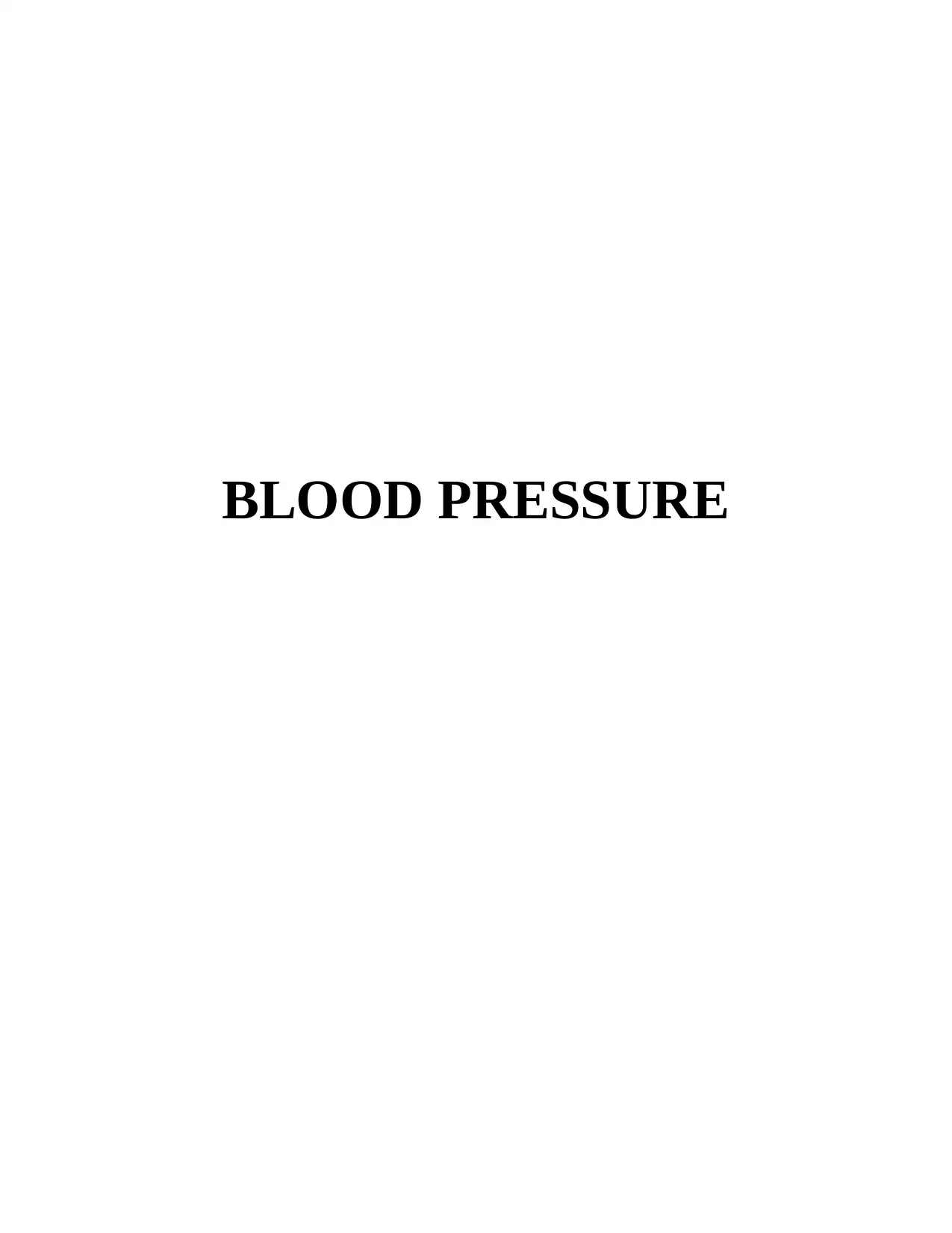
BLOOD PRESSURE
Paraphrase This Document
Need a fresh take? Get an instant paraphrase of this document with our AI Paraphraser
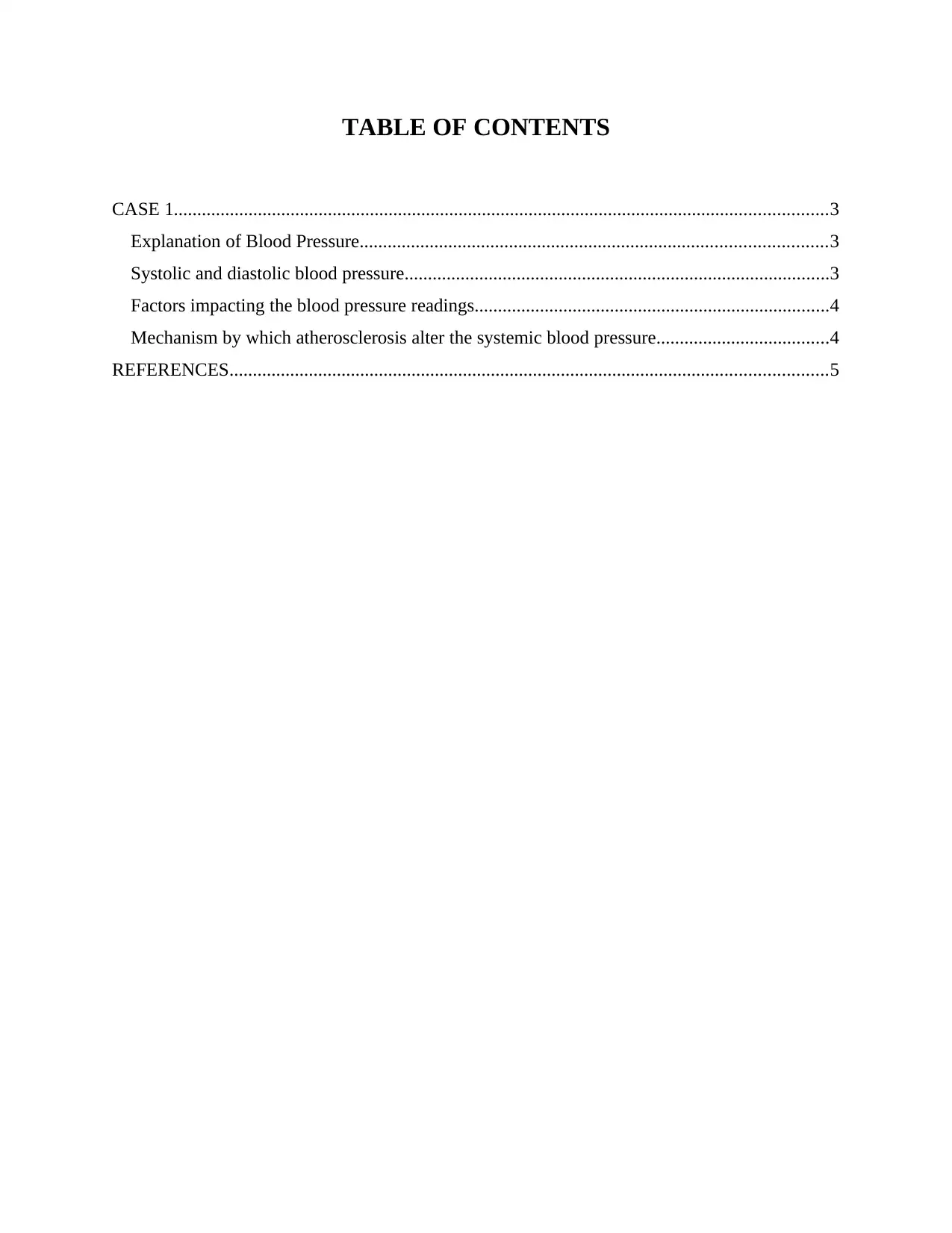
TABLE OF CONTENTS
CASE 1............................................................................................................................................3
Explanation of Blood Pressure....................................................................................................3
Systolic and diastolic blood pressure...........................................................................................3
Factors impacting the blood pressure readings............................................................................4
Mechanism by which atherosclerosis alter the systemic blood pressure.....................................4
REFERENCES................................................................................................................................5
CASE 1............................................................................................................................................3
Explanation of Blood Pressure....................................................................................................3
Systolic and diastolic blood pressure...........................................................................................3
Factors impacting the blood pressure readings............................................................................4
Mechanism by which atherosclerosis alter the systemic blood pressure.....................................4
REFERENCES................................................................................................................................5
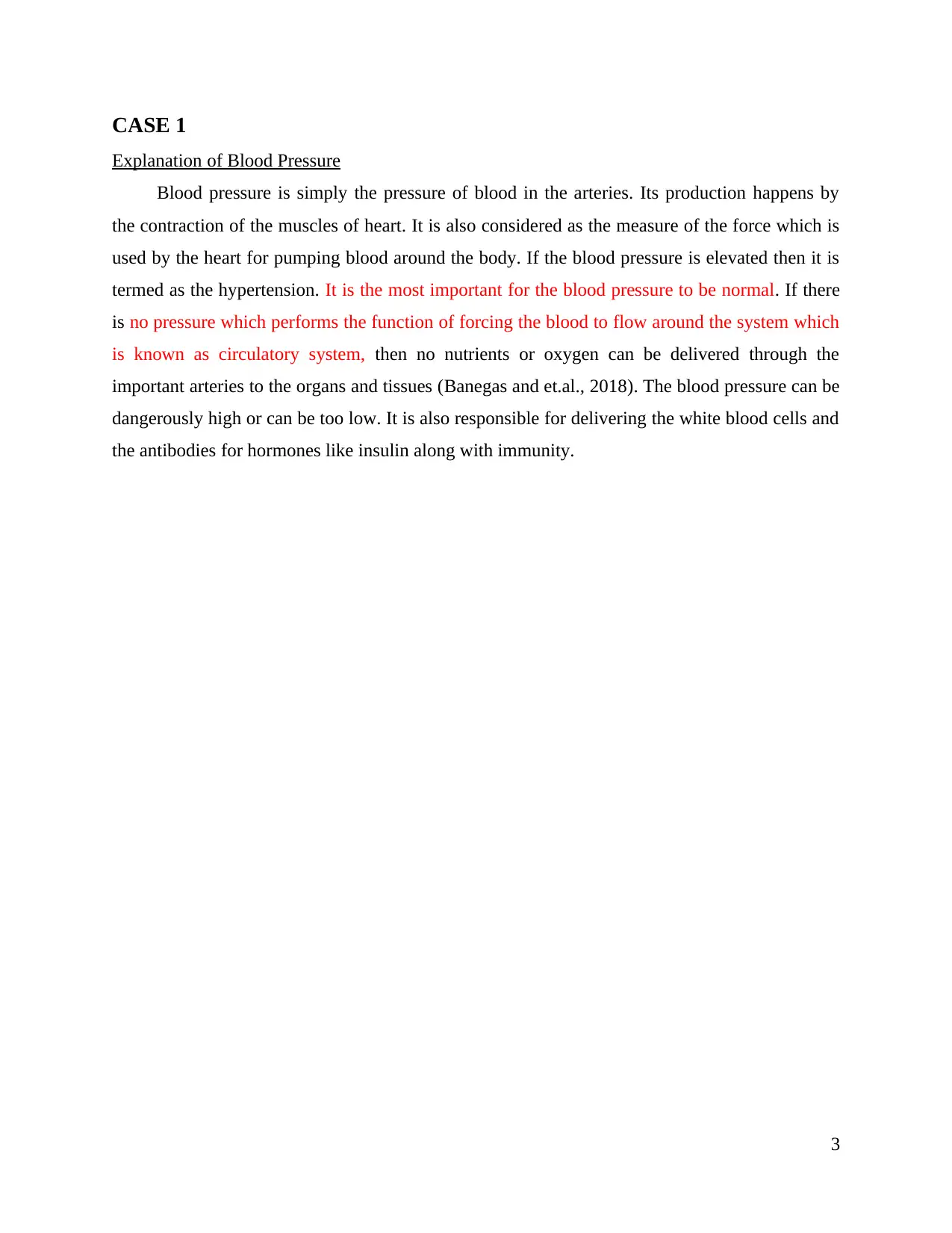
CASE 1
Explanation of Blood Pressure
Blood pressure is simply the pressure of blood in the arteries. Its production happens by
the contraction of the muscles of heart. It is also considered as the measure of the force which is
used by the heart for pumping blood around the body. If the blood pressure is elevated then it is
termed as the hypertension. It is the most important for the blood pressure to be normal. If there
is no pressure which performs the function of forcing the blood to flow around the system which
is known as circulatory system, then no nutrients or oxygen can be delivered through the
important arteries to the organs and tissues (Banegas and et.al., 2018). The blood pressure can be
dangerously high or can be too low. It is also responsible for delivering the white blood cells and
the antibodies for hormones like insulin along with immunity.
3
Explanation of Blood Pressure
Blood pressure is simply the pressure of blood in the arteries. Its production happens by
the contraction of the muscles of heart. It is also considered as the measure of the force which is
used by the heart for pumping blood around the body. If the blood pressure is elevated then it is
termed as the hypertension. It is the most important for the blood pressure to be normal. If there
is no pressure which performs the function of forcing the blood to flow around the system which
is known as circulatory system, then no nutrients or oxygen can be delivered through the
important arteries to the organs and tissues (Banegas and et.al., 2018). The blood pressure can be
dangerously high or can be too low. It is also responsible for delivering the white blood cells and
the antibodies for hormones like insulin along with immunity.
3
⊘ This is a preview!⊘
Do you want full access?
Subscribe today to unlock all pages.

Trusted by 1+ million students worldwide
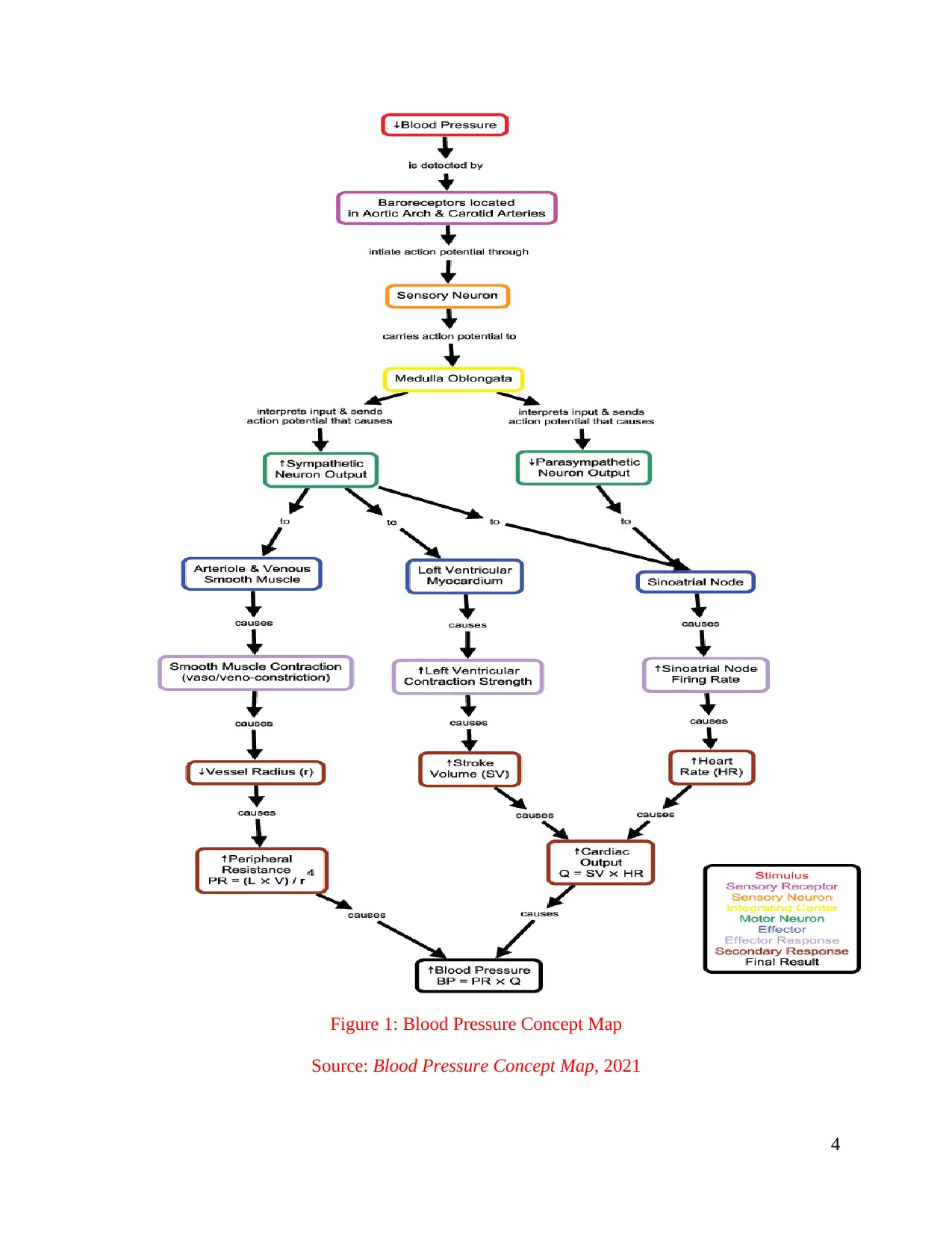
Figure 1: Blood Pressure Concept Map
Source: Blood Pressure Concept Map, 2021
4
Source: Blood Pressure Concept Map, 2021
4
Paraphrase This Document
Need a fresh take? Get an instant paraphrase of this document with our AI Paraphraser
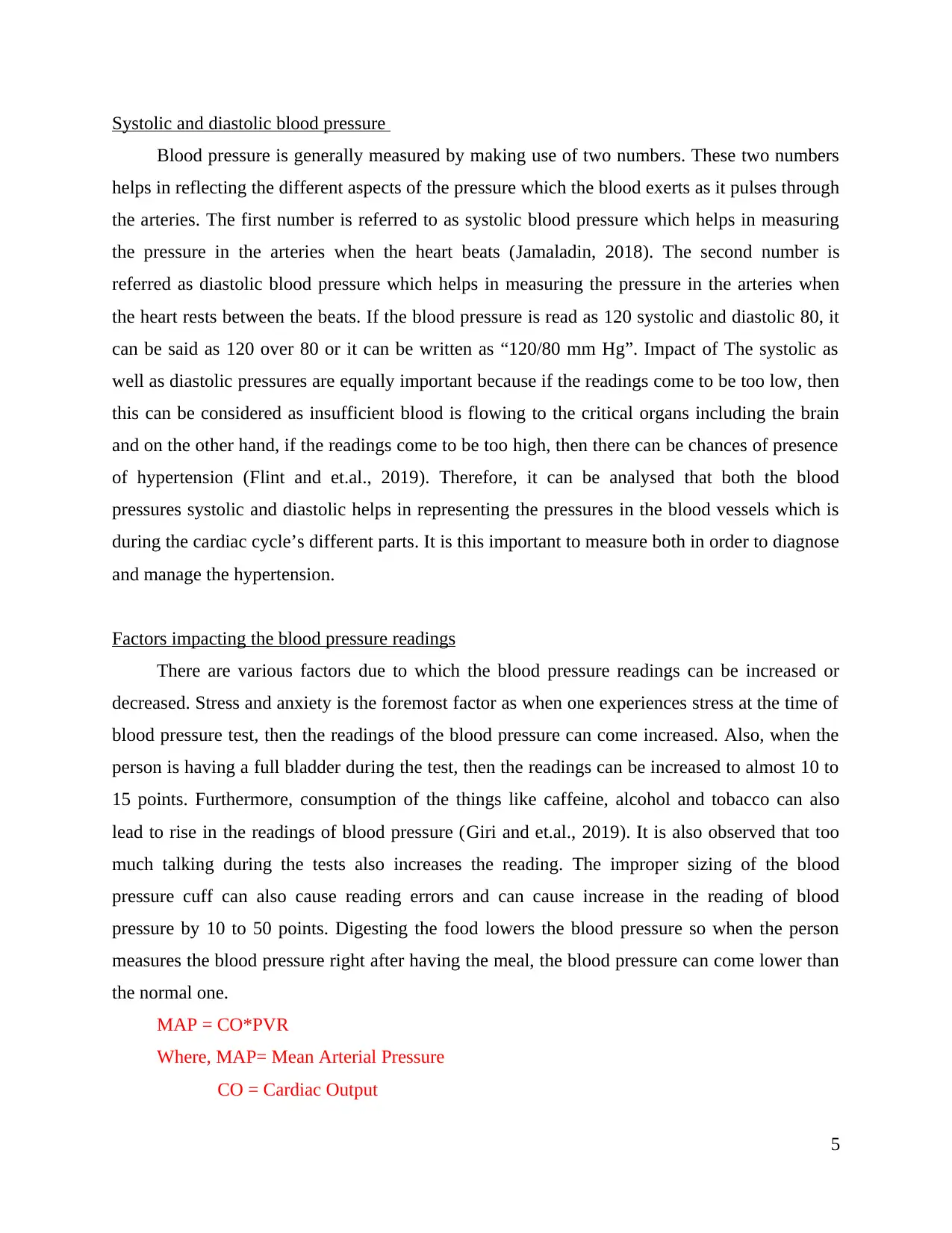
Systolic and diastolic blood pressure
Blood pressure is generally measured by making use of two numbers. These two numbers
helps in reflecting the different aspects of the pressure which the blood exerts as it pulses through
the arteries. The first number is referred to as systolic blood pressure which helps in measuring
the pressure in the arteries when the heart beats (Jamaladin, 2018). The second number is
referred as diastolic blood pressure which helps in measuring the pressure in the arteries when
the heart rests between the beats. If the blood pressure is read as 120 systolic and diastolic 80, it
can be said as 120 over 80 or it can be written as “120/80 mm Hg”. Impact of The systolic as
well as diastolic pressures are equally important because if the readings come to be too low, then
this can be considered as insufficient blood is flowing to the critical organs including the brain
and on the other hand, if the readings come to be too high, then there can be chances of presence
of hypertension (Flint and et.al., 2019). Therefore, it can be analysed that both the blood
pressures systolic and diastolic helps in representing the pressures in the blood vessels which is
during the cardiac cycle’s different parts. It is this important to measure both in order to diagnose
and manage the hypertension.
Factors impacting the blood pressure readings
There are various factors due to which the blood pressure readings can be increased or
decreased. Stress and anxiety is the foremost factor as when one experiences stress at the time of
blood pressure test, then the readings of the blood pressure can come increased. Also, when the
person is having a full bladder during the test, then the readings can be increased to almost 10 to
15 points. Furthermore, consumption of the things like caffeine, alcohol and tobacco can also
lead to rise in the readings of blood pressure (Giri and et.al., 2019). It is also observed that too
much talking during the tests also increases the reading. The improper sizing of the blood
pressure cuff can also cause reading errors and can cause increase in the reading of blood
pressure by 10 to 50 points. Digesting the food lowers the blood pressure so when the person
measures the blood pressure right after having the meal, the blood pressure can come lower than
the normal one.
MAP = CO*PVR
Where, MAP= Mean Arterial Pressure
CO = Cardiac Output
5
Blood pressure is generally measured by making use of two numbers. These two numbers
helps in reflecting the different aspects of the pressure which the blood exerts as it pulses through
the arteries. The first number is referred to as systolic blood pressure which helps in measuring
the pressure in the arteries when the heart beats (Jamaladin, 2018). The second number is
referred as diastolic blood pressure which helps in measuring the pressure in the arteries when
the heart rests between the beats. If the blood pressure is read as 120 systolic and diastolic 80, it
can be said as 120 over 80 or it can be written as “120/80 mm Hg”. Impact of The systolic as
well as diastolic pressures are equally important because if the readings come to be too low, then
this can be considered as insufficient blood is flowing to the critical organs including the brain
and on the other hand, if the readings come to be too high, then there can be chances of presence
of hypertension (Flint and et.al., 2019). Therefore, it can be analysed that both the blood
pressures systolic and diastolic helps in representing the pressures in the blood vessels which is
during the cardiac cycle’s different parts. It is this important to measure both in order to diagnose
and manage the hypertension.
Factors impacting the blood pressure readings
There are various factors due to which the blood pressure readings can be increased or
decreased. Stress and anxiety is the foremost factor as when one experiences stress at the time of
blood pressure test, then the readings of the blood pressure can come increased. Also, when the
person is having a full bladder during the test, then the readings can be increased to almost 10 to
15 points. Furthermore, consumption of the things like caffeine, alcohol and tobacco can also
lead to rise in the readings of blood pressure (Giri and et.al., 2019). It is also observed that too
much talking during the tests also increases the reading. The improper sizing of the blood
pressure cuff can also cause reading errors and can cause increase in the reading of blood
pressure by 10 to 50 points. Digesting the food lowers the blood pressure so when the person
measures the blood pressure right after having the meal, the blood pressure can come lower than
the normal one.
MAP = CO*PVR
Where, MAP= Mean Arterial Pressure
CO = Cardiac Output
5
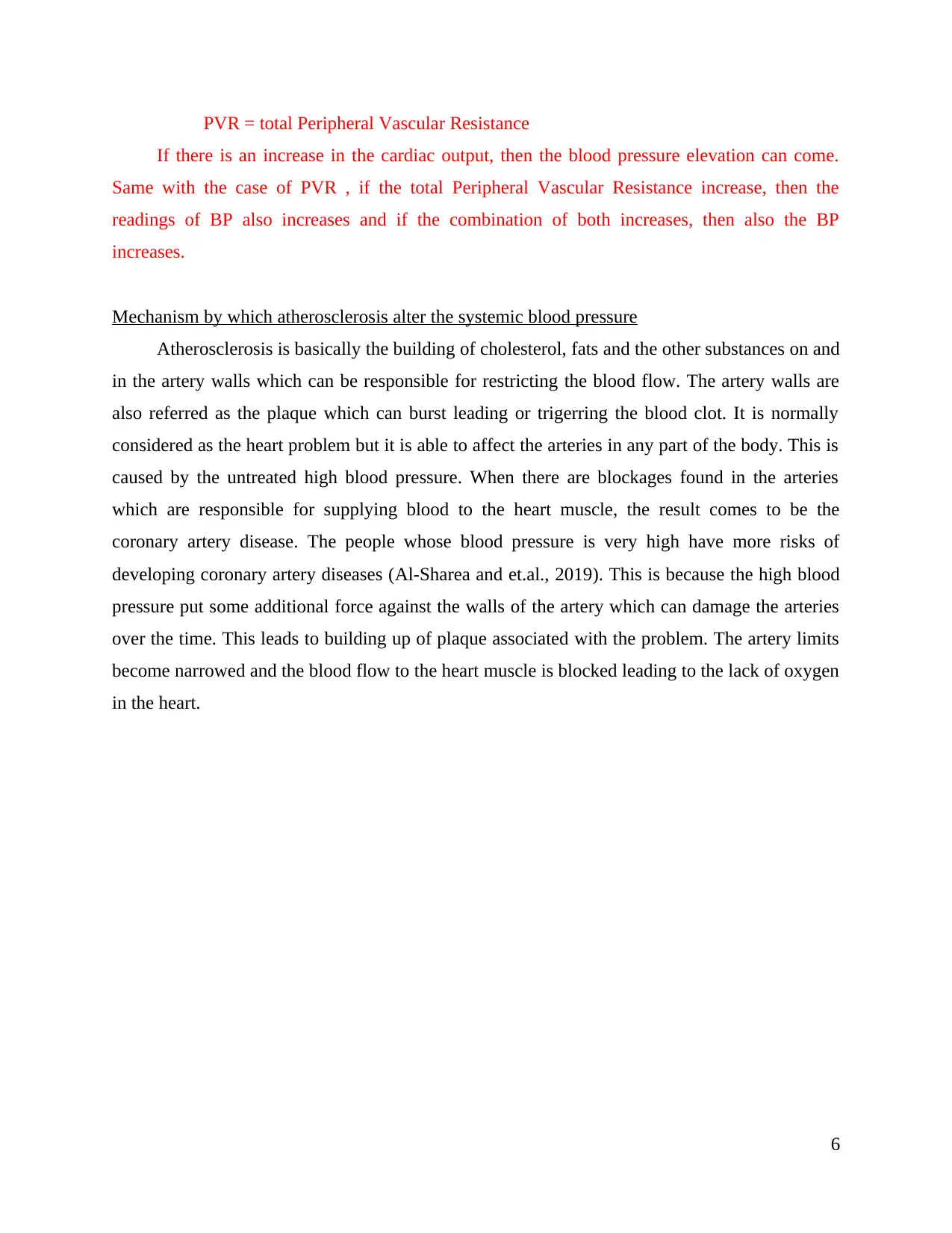
PVR = total Peripheral Vascular Resistance
If there is an increase in the cardiac output, then the blood pressure elevation can come.
Same with the case of PVR , if the total Peripheral Vascular Resistance increase, then the
readings of BP also increases and if the combination of both increases, then also the BP
increases.
Mechanism by which atherosclerosis alter the systemic blood pressure
Atherosclerosis is basically the building of cholesterol, fats and the other substances on and
in the artery walls which can be responsible for restricting the blood flow. The artery walls are
also referred as the plaque which can burst leading or trigerring the blood clot. It is normally
considered as the heart problem but it is able to affect the arteries in any part of the body. This is
caused by the untreated high blood pressure. When there are blockages found in the arteries
which are responsible for supplying blood to the heart muscle, the result comes to be the
coronary artery disease. The people whose blood pressure is very high have more risks of
developing coronary artery diseases (Al-Sharea and et.al., 2019). This is because the high blood
pressure put some additional force against the walls of the artery which can damage the arteries
over the time. This leads to building up of plaque associated with the problem. The artery limits
become narrowed and the blood flow to the heart muscle is blocked leading to the lack of oxygen
in the heart.
6
If there is an increase in the cardiac output, then the blood pressure elevation can come.
Same with the case of PVR , if the total Peripheral Vascular Resistance increase, then the
readings of BP also increases and if the combination of both increases, then also the BP
increases.
Mechanism by which atherosclerosis alter the systemic blood pressure
Atherosclerosis is basically the building of cholesterol, fats and the other substances on and
in the artery walls which can be responsible for restricting the blood flow. The artery walls are
also referred as the plaque which can burst leading or trigerring the blood clot. It is normally
considered as the heart problem but it is able to affect the arteries in any part of the body. This is
caused by the untreated high blood pressure. When there are blockages found in the arteries
which are responsible for supplying blood to the heart muscle, the result comes to be the
coronary artery disease. The people whose blood pressure is very high have more risks of
developing coronary artery diseases (Al-Sharea and et.al., 2019). This is because the high blood
pressure put some additional force against the walls of the artery which can damage the arteries
over the time. This leads to building up of plaque associated with the problem. The artery limits
become narrowed and the blood flow to the heart muscle is blocked leading to the lack of oxygen
in the heart.
6
⊘ This is a preview!⊘
Do you want full access?
Subscribe today to unlock all pages.

Trusted by 1+ million students worldwide
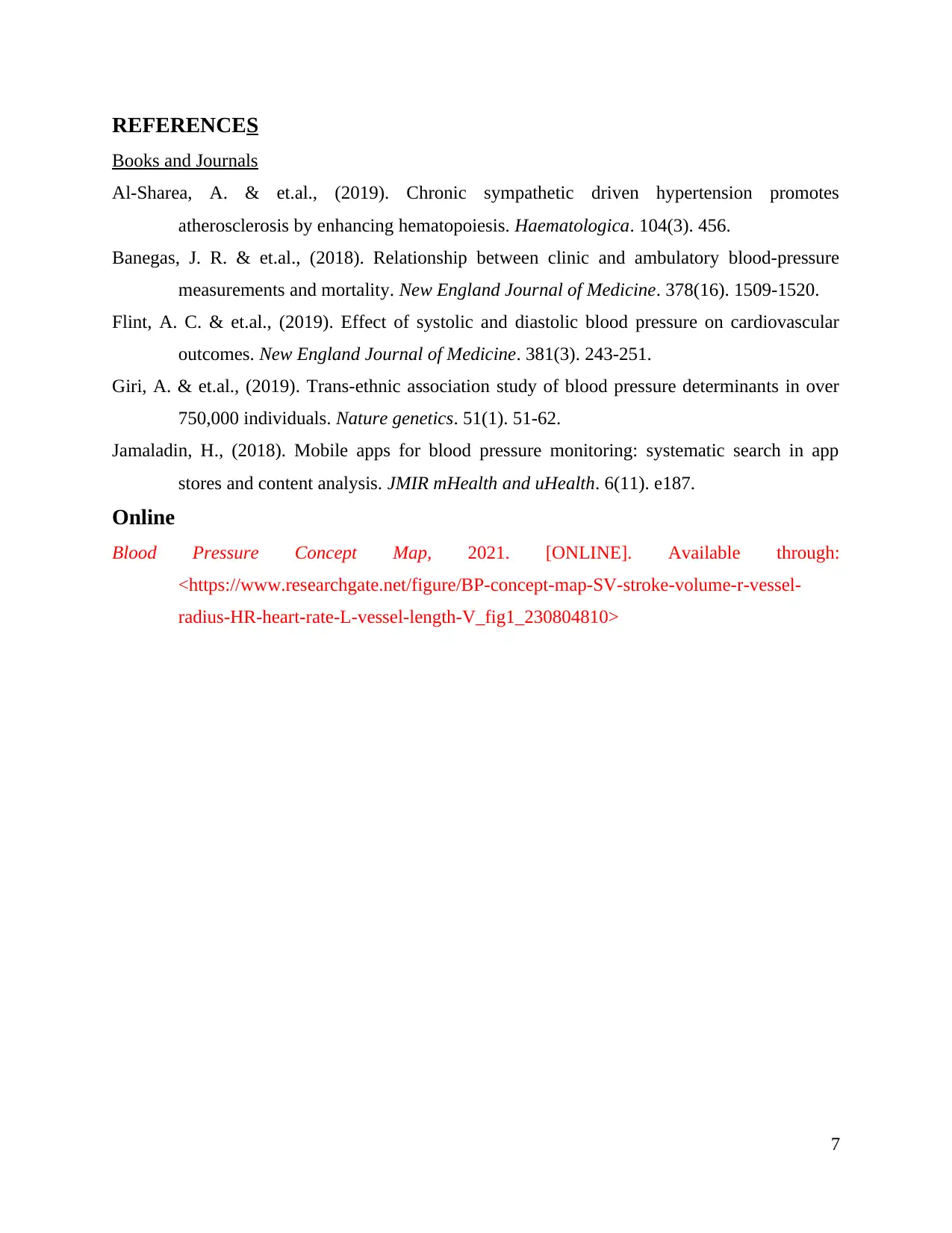
REFERENCES
Books and Journals
Al-Sharea, A. & et.al., (2019). Chronic sympathetic driven hypertension promotes
atherosclerosis by enhancing hematopoiesis. Haematologica. 104(3). 456.
Banegas, J. R. & et.al., (2018). Relationship between clinic and ambulatory blood-pressure
measurements and mortality. New England Journal of Medicine. 378(16). 1509-1520.
Flint, A. C. & et.al., (2019). Effect of systolic and diastolic blood pressure on cardiovascular
outcomes. New England Journal of Medicine. 381(3). 243-251.
Giri, A. & et.al., (2019). Trans-ethnic association study of blood pressure determinants in over
750,000 individuals. Nature genetics. 51(1). 51-62.
Jamaladin, H., (2018). Mobile apps for blood pressure monitoring: systematic search in app
stores and content analysis. JMIR mHealth and uHealth. 6(11). e187.
Online
Blood Pressure Concept Map, 2021. [ONLINE]. Available through:
<https://www.researchgate.net/figure/BP-concept-map-SV-stroke-volume-r-vessel-
radius-HR-heart-rate-L-vessel-length-V_fig1_230804810>
7
Books and Journals
Al-Sharea, A. & et.al., (2019). Chronic sympathetic driven hypertension promotes
atherosclerosis by enhancing hematopoiesis. Haematologica. 104(3). 456.
Banegas, J. R. & et.al., (2018). Relationship between clinic and ambulatory blood-pressure
measurements and mortality. New England Journal of Medicine. 378(16). 1509-1520.
Flint, A. C. & et.al., (2019). Effect of systolic and diastolic blood pressure on cardiovascular
outcomes. New England Journal of Medicine. 381(3). 243-251.
Giri, A. & et.al., (2019). Trans-ethnic association study of blood pressure determinants in over
750,000 individuals. Nature genetics. 51(1). 51-62.
Jamaladin, H., (2018). Mobile apps for blood pressure monitoring: systematic search in app
stores and content analysis. JMIR mHealth and uHealth. 6(11). e187.
Online
Blood Pressure Concept Map, 2021. [ONLINE]. Available through:
<https://www.researchgate.net/figure/BP-concept-map-SV-stroke-volume-r-vessel-
radius-HR-heart-rate-L-vessel-length-V_fig1_230804810>
7
1 out of 7
Related Documents
Your All-in-One AI-Powered Toolkit for Academic Success.
+13062052269
info@desklib.com
Available 24*7 on WhatsApp / Email
![[object Object]](/_next/static/media/star-bottom.7253800d.svg)
Unlock your academic potential
Copyright © 2020–2025 A2Z Services. All Rights Reserved. Developed and managed by ZUCOL.




